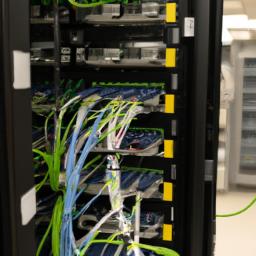In the pulsating realm where machinery hums and innovation thrives, the delicate ballet of managing equipment loans often takes center stage. Picturing it can evoke the image of a tightrope walker balancing deftly between the opportunities of equipped readiness and the precarious precipice of financial commitment. Whether it’s a bustling construction site, a high-tech laboratory, or a creative studio swirling with ideas, having the right gear at the right time can be the keystone of success. However, the art of navigating this territory with skill and prudence is no small feat. Herein lies your guide to mastering the choreography of equipment loans, ensuring that every step you take leads to efficiency, affordability, and a seamless symphony of operational excellence.
Evaluating Financial Feasibility before Taking the Leap
One of the first steps in managing an equipment loan is to evaluate its financial feasibility. This involves scrutinizing various aspects to ensure that the loan aligns with your business objectives and financial health. Start by understanding the total cost of ownership (TCO), which includes not just the price of the equipment, but also associated expenses like maintenance, insurance, and eventual disposal.
Conduct a thorough cost-benefit analysis. Compare the projected revenue or operational efficiencies you’ll gain from the new equipment against the financial burden of loan repayments. List the possible advantages such as increased productivity, energy savings, or enhanced product quality. Weigh these against the interest rates, fees, and the downturn risk if the equipment doesn’t perform as expected.
| Factor | Potential Impact |
|---|---|
| Interest Rate | Directly affects monthly repayments |
| Loan Term | Longer terms mean lower payments but higher total interest |
| Maintenance Costs | Can add significant ongoing expenses |
Assess your cash flow to ensure you can comfortably handle the loan repayments. Create a projected cash flow statement if you don’t already have one. This will help you visualize your financial position and anticipate any potential shortfalls. Remember that missing a loan payment can damage your credit score and hamper future financing opportunities.
Consider the state of your creditworthiness. A stronger credit score can secure you a lower interest rate, reducing the financial strain. Check your credit report for any discrepancies and rectify them to improve your score. If your score is less than stellar, you may need to pay a higher interest rate or provide collateral.
Another critical aspect is understanding the market value of the equipment. Investigate the equipment’s resale value and rate of depreciation. This will help you determine whether leasing might be a better option than purchasing via a loan. Often, rapidly depreciating assets might not justify the acquisition through high-interest loans.
Scenario analysis is another useful tool. Develop best-case and worst-case financial scenarios to see how the equipment loan will affect your business under different conditions. For instance, if you encounter a sudden downturn, will you still be able to make your loan payments? Being prepared for various outcomes will help you decide whether to proceed with the loan.
Lastly, employ the debt service coverage ratio (DSCR). This is a measure that compares your business’s operating income to its debt obligations. A DSCR greater than 1 indicates your business has more income than necessary to cover its debts, including the equipment loan. This ratio can provide additional reassurance that taking on the loan won’t jeopardize your financial stability.
By meticulously evaluating these financial aspects, you can make a well-informed decision about whether to proceed with an equipment loan. This careful analysis will help ensure that the loan will be a strategic asset rather than a financial burden.

Crafting an Effective Repayment Strategy
To stay on top of your equipment loan, it’s paramount to develop a smart and effective repayment strategy. This requires careful consideration of your business’s cash flow, loan terms, and financial goals.
Understand Your Loan Terms:
The first step is to fully understand the terms of your loan. Evaluate the interest rates, repayment schedule, and any penalties for late or missed payments. Knowing the total cost of the loan over its life can help in making realistic financial projections.
Create a Detailed Budget:
Constructing a detailed budget is the backbone of any effective repayment plan. List all your fixed and variable expenses, and compare them to your income streams. Highlight the loan repayments as a priority within your budget to ensure they are always covered.
| Income | Fixed Expenses | Variable Expenses | Loan Repayment |
|---|---|---|---|
| $10,000 | $3,000 | $2,500 | $1,500 |
Automate Your Payments:
Utilize modern technology by setting up automated payments. This will not only help avoid missed payments, which can negatively impact your credit score, but also simplify your financial management process.
Build an Emergency Fund:
Unexpected expenses can derail even the best-laid plans. Establish an emergency fund that can cover at least 3-6 months of loan repayments. This cushion can help you stay on track even when unforeseen financial hurdles arise.
Communicate with Your Lender:
Fostering a good relationship with your lender can be incredibly beneficial. If you anticipate any difficulty in making a payment, communicate immediately. Lenders may offer temporary relief measures like adjusted repayment schedules or deferred payments.
Track Your Progress:
Regularly reviewing your repayment progress keeps you motivated and accountable. Use financial software or simple spreadsheets to track how much you’ve paid and how much is still owed. Celebrate small milestones to maintain morale.
- Regular Reviews: Monthly review sessions to track payment progress.
- Adjustments: Make necessary adjustments to your budget and payment plan.
- Milestone Celebrations: Set small goals and celebrate when you achieve them.
Explore Refinancing Options:
If you find yourself in a strong financial position or if interest rates drop, consider refinancing your loan. Refinancing might secure you a lower interest rate or better repayment terms, making your loan more manageable and potentially saving you money in the long run.
Leverage Additional Income:
look for ways to bolster your income. Whether it’s taking on additional work, launching a side business, or selling unused assets, extra income can go directly towards your loan repayments to accelerate your path to becoming debt-free.
implementing a repayment strategy requires a multifaceted approach. By understanding your loan terms, budgeting efficiently, leveraging technology, and staying proactive, you can set a clear path to managing your equipment loan effectively.

Maintaining Equipment to Maximize Value
To ensure the longevity and efficiency of your equipment, regular and proper maintenance is crucial. Maintenance goes beyond simple cleaning; it encompasses timely inspections, urgent repairs, and adherence to manufacturer guidelines.
Begin with a Schedule: Develop a maintenance schedule that outlines routine checks and servicing. This could be on a weekly, monthly, or quarterly basis, depending on the equipment’s usage and manufacturer’s recommendations. Stick to this schedule religiously to avoid unexpected breakdowns.
Documentation: Keep detailed records of all maintenance activities, including dates, types of service performed, parts replaced, and the technicians’ names. This documentation can act as proof of diligence when returning the equipment and can also help in identifying recurring issues.
Staff Training: Ensure that everyone who uses the equipment is fully trained on proper operation and basic troubleshooting. An educated team is less likely to misuse equipment, thereby extending its life and maintaining its value.
Use Quality Supplies: Always use manufacturer-recommended or high-quality supplies, whether it’s lubricants, replacement parts, or cleaning materials. Substandard supplies can lead to rapid wear and tear, ultimately devaluing the equipment.
Inspection Checklist:
- Check for wear and tear on moving parts.
- Inspect for any leaks, rust, or cracks.
- Ensure that safety features and guards are intact and functional.
- Verify that electrical components are working and not overloading.
Keep a maintenance log for day-to-day entries where operators can note any unusual behavior or minor hitches. This proactive approach can alert you to issues before they become significant problems.
Maintenance Log Example:
| Date | Equipment ID | Issue Reported | Action Taken | Technician |
|---|---|---|---|---|
| 2023-10-04 | EQ-12345 | Unusual noise from motor | Lubricated bearings | John Doe |
| 2023-10-10 | EQ-12346 | Display screen flickering | Replaced screen cable | Jane Smith |
Act swiftly on small repairs: Even minor issues should be addressed promptly to prevent them from escalating into major, costlier problems. Timely intervention preserves the equipment’s functionality and its market value significantly.

Understanding Legal Obligations and Documentation
Managing an equipment loan requires comprehensive knowledge of the associated legal obligations and documentation to safeguard both parties. Whether you are the lender or borrower, understanding the terms and conditions can prevent misunderstandings and potential legal complications.
Reviewing the Loan Agreement
Before finalizing any equipment loan, meticulously review the loan agreement. Key elements to focus on include:
- Descriptions of the Equipment: Ensure that the model, serial number, and condition of the equipment are explicitly stated.
- Loan Duration: Clearly define the start and end dates of the loan period.
- Responsibilities: Outline maintenance, operation, and insurance obligations.
Legal Responsibilities and Liabilities
Both parties must understand their legal responsibilities and potential liabilities. These typically include:
- Borrower’s Duties: Proper use and regular maintenance of the equipment.
- Lender’s Duties: Providing equipment in good working condition and offering necessary operational instructions.
- Insurance Requirements: Verification of adequate coverage to protect against damage, loss, or theft.
Maintaining Proper Documentation
Keep all loan-related documents organized and accessible. Essential documents may include:
- Loan Agreement: The primary contract outlining the loan terms.
- Insurance Papers: Proof of insurance covering the loaned equipment.
- Inspection Reports: Documentation of the equipment’s condition before and after the loan term.
Equipment Inspection
Conducting regular inspections is crucial to prevent disputes. Important inspection points are:
| Inspection Point | Description |
|---|---|
| Initial Condition | Document the state of the equipment pre-loan. |
| Usage Logs | Keep a log of how and when the equipment is used. |
| Post-Loan Check | Assess the equipment’s condition post-loan to identify any damages or wear. |
Amendment of Terms
Sometimes, the initial terms might need modification. If a change is necessary, ensure both parties agree in writing. Amendments should be clearly documented and signed by both parties to maintain legal integrity.
Understanding the Consequences of Default
Both parties should also be aware of the consequences if either side defaults on the agreement. Typical repercussions can include:
- For the Borrower: Financial penalties, legal action, and potential damage to credit ratings.
- For the Lender: Recovery of the equipment, financial reimbursement, and compensation for damages.
Becoming well-versed in these aspects ensures a smooth and conflict-free equipment loan process.
Insights and Conclusions
As we draw the curtain on our exploration of managing equipment loans, it’s clear that navigating this process requires keen attention and strategic planning. Whether you’re an entrepreneur gearing up for growth, an academic striving for groundbreaking research, or an artisan perfecting your craft, managing an equipment loan effectively can be a linchpin to your endeavors.
From assessing your true needs and carefully vetting lenders to drafting watertight agreements and maintaining diligent financial oversight, each step plays a crucial role in ensuring your venture remains on solid ground. As you move forward, remember that the success of an equipment loan isn’t just measured in financial terms but in the realization of your ambitions and the sustainable growth of your work.
May your path be illuminated with informed decisions and fortified with judicious management. After all, the right equipment, leveraged wisely, can be the catalyst that turns potential into tangible achievement.
Here’s to your illuminated journey ahead, where vision meets precision and opportunity blossoms into reality.
